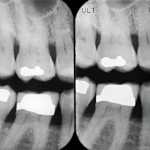
The aim of this review is to give an updated answer to the question whether the additional use of Enamel matrix derivative (EMD) in periodontal therapy is more effective in comparison to control or other regenerative procedures.
The authors searched MEDLINE (PubMed) for randomized controlled trials where EMD was used for treatment of intrabony defects, furcations and recessions. The primary outcome variable for intrabony defects was the change in clinical attachment level, for furcations the change in horizontal furcation depth and for recession complete root coverage.
They included 27 studies (20 for intrabony defects,1 for furcation and 6 for recession) and performed a meta-analysis for intrabony defects and recession
They found that
- The treatment of intrabony defects with EMD showed a significant additional gain in clinical attachment of 1.30 mm in comparison to open flap debridement, EDTA or placebo, but no significant difference in comparison to resorbable membranes was shown.
- The use of EMD in combination with a coronally advanced flap compared to a coronally advanced flap alone showed significant more complete root coverage (OR=3.5), but in comparison to a connective tissue graft the result was not significantly different.
- The use of EMD in furcations (2.6±1.8 mm) gave significant more improvement in horizontal defect depth in comparison to resorbable membranes (1.9±1.4 mm) as shown in one study.
The authors concluded
In the treatment of intrabony defects the use of EMD is superior to control treatments, but as effective as resorbable membranes. The additional use of EMD with a coronally advanced flap for recession coverage will give superior results in comparison to control, but is as effective as a connective tissue graft. The use of EMD in furcations will give more reduction in horizontal furcation defect depth as resorbable membranes.
Koop R, Merheb J, Quirynen M. Periodontal Regeneration With Enamel Matrix Derivative (EMD) in Reconstructive Periodontal Therapy. A Systematic Review. J Periodontol. 2011 Nov 3. [Epub ahead of print] PubMed PMID: 22050544.
It is interesting to compare this review with an earlier review from the Cochrane Oral Health Group last updated in 2009.
Esposito M, Grusovin MG, Papanikolaou N, Coulthard P, Worthington HV. Enamel matrix derivative (Emdogain(R)) for periodontal tissue regeneration in intrabony defects. Cochrane Database Syst Rev. 2009 Oct 7;(4):CD003875. Review. PubMed PMID: 19821315.
They concluded:-
One year after its application, EMD significantly improved probing attachment levels (1.1 mm) and pocket depth reduction (0.9 mm) when compared to a placebo or control, however, the high degree of heterogeneity observed among trials suggests that results have to be interpreted with great caution. In addition, a sensitivity analysis indicated that the overall treatment effect might be overestimated. The actual clinical advantages of using EMD are unknown. With the exception of significantly more postoperative complications in the guided tissue regeneration (GTR) group, there was no evidence of clinically important differences between GTR and EMD. Bone substitutes may be associated with less gingival recessions than EMD.
